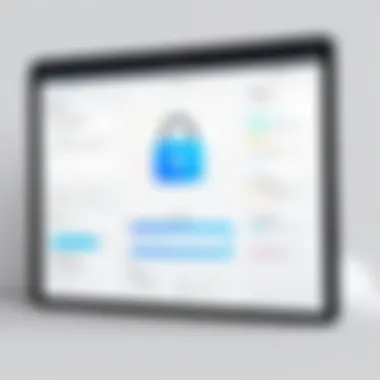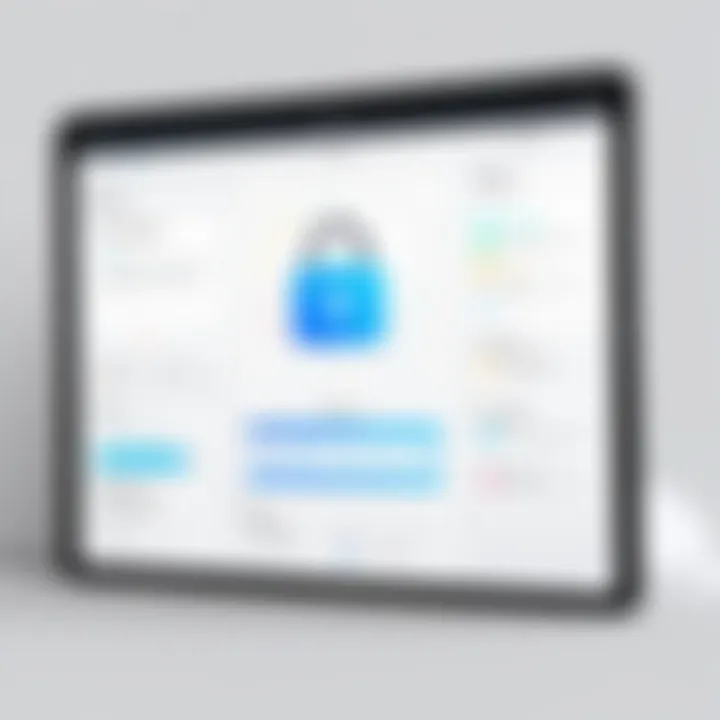Unlocking Your iPad: Comprehensive Solutions


Intro
In today's fast-paced digital landscape, iPads serve as essential tools for work, entertainment, and communication. However, encountering a locked device can be a frustrating experience. Whether it’s due to forgotten passcodes, failed software updates, or any other issues, regaining access is crucial. This guide outlines effective methods to unlock your iPad, ranging from official solutions provided by Apple to alternative techniques offered by third-party services. Understanding these methods not only helps regain access but also enhances your troubleshooting skills for future incidents.
Overview of the Technology
iPads, designed by Apple, come equipped with advanced specifications and features. The operating system, iPadOS, regularly receives updates that enhance performance and security. These devices typically include Retina displays, powerful processors such as the A-series chips, and a range of storage options to accommodate diverse user needs.
- Key specifications• Retina display technology for vibrant visuals
• A-series chip for high performance and efficiency
• Multiple storage capacities, including 64GB, 256GB, and higher
• Advanced security features including Touch ID and Face ID - Unique selling points• Seamless integration within the Apple ecosystem
• Extensive app availability through the App Store
• Strong focus on user privacy and data protection
• Regular software updates enhancing security and performance
Design and Build Quality
Apple prioritizes quality and usability in its product design. The iPad's sleek exterior is not merely for aesthetics but contributes to functionality and user experience.
- Material used• Aluminum chassis for durability and lightweight handling
• Scratch-resistant glass for display protection - Ergonomics and usability• Comfortable to hold for extended periods
• Intuitive touch interface for easy navigation
With robust design and technology, iPads are well-suited for both casual and professional use. Understanding the device's features can assist in efficiently tackling issues when they arise, such as when locking occurs.
Intro to Locked iPads
A locked iPad can be a frustrating barrier for users seeking access to their devices. Understanding the implications of a locked device is crucial, not only for usability but also for the security of personal data. This section lays the groundwork for recognizing different types of iPad locks, their causes, and initial consideration for resolution.
When an iPad is locked, it can affect productivity, communication, and entertainment. It is common to encounter this issue due to various reasons like forgotten passcodes or attempted unauthorized access. The significance of discussing locked iPads in this article stems from the growing reliance on these devices in daily life.
The key benefits of understanding locked iPads include:
- Awareness of how such locks function.
- Recognition of potential issues that cause locks.
- Guidance on methods to restore access.
Establishing familiarity with the mechanisms and reasons behind locked iPads fosters better self-management of Apple devices, promoting a proactive approach against future locking incidents. In the following sections, we will dissect these aspects further, providing you with essential strategies for addressing locked situations effectively.
Understanding the iPad Lock Mechanism
The iPad locking mechanism is primarily designed to protect user data and maintain device integrity. The lock can be tied to various features, including passcodes and security settings. The default security method is a passcode lock, which requires numerical input to unlock. User-defined settings may also enable additional measures such as biometric authentication.
When an incorrect passcode is entered multiple times, iPad security protocols automatically initiate a lockdown process. This results in limited access to the device, distancing potential unauthorized users from personal information stored within. Apple's security framework aims to strike a balance between usability and protection against threats.
Common Causes for Locking
Several factors contribute to the locking of an iPad. Understanding these causes can aid users in preventing similar situations in the future. Here are the most frequently encountered reasons:
- Forgotten Passcodes: This is the most prevalent cause. Users may simply forget their passcodes, especially if they do not use it often.
- Failed Attempts: Repeatedly entering the wrong passcode can result in temporary or permanent locking.
- Software Glitches: Sometimes, issues caused by software updates or abnormal device behavior can lead to unintended locking.
- Parental Controls: Engaging these settings without remembering the configured passcode can lock users out of their devices.
Understanding these common causes not only helps in identifying locking scenarios promptly but also serves as a reflective point for enhancing device usage patterns.
Identifying the Type of Lock
When dealing with a locked iPad, the first crucial step is to identify the type of lock that has been activated. Understanding the specific lock type helps in choosing the most effective unlocking method. Different locks protect against various situations and unauthorized access. Therefore, knowing whether you are facing a passcode lock, activation lock, or a screen time passcode issue is essential for a smooth resolution.
Passcode Lock
A passcode lock is the most common form of security on iPads. It requires a numeric code or a pattern to unlock the device. This system is designed to prevent unauthorized access to personal information. If you forget this passcode, you cannot access the iPad. The main concern here is to regain access without losing your data.
If you find yourself locked out due to a forgotten passcode, it is important to understand the potential consequences of unlocking methods, as many of them may lead to data loss. Check for recent backups in iCloud or on your computer that can help restore your data after unlocking the device.
Activation Lock


Activation Lock is a security feature linked to your Apple ID. This lock is automatically enabled when you turn on Find My iPad. Its purpose is to deter theft by requiring the Apple ID and password of the original owner to unlock the device. If you purchase a second-hand iPad and discover it is activation locked, resolving this issue involves contacting the previous owner for their Apple ID details.
If you don’t have access to the original owner, you may end up needing to use Apple’s support services. Proving ownership might be necessary, which can take time and effort. Be prepared for this scenario before attempting to remove Activation Lock.
Screen Time Passcode
Finally, a Screen Time passcode is a feature that helps parents manage how much time their children spend on apps and features of the iPad. If you forget this passcode, it can hinder access to certain functionalities and settings.
Recovering from this type of lock usually involves using your Apple ID to reset the settings. If the Apple ID is lost, exploring recovery methods becomes essential. In some cases, you might need to reset the device to its factory settings, which can lead to extensive data loss if backups are not available.
Identifying the type of lock effectively influences the next steps you must take. Each lock presents unique challenges and necessary solutions, making recognition of the specific lock a step that cannot be overstated.
Preliminary Steps Before Unlocking
Before jumping into various methods for unlocking an iPad, it is crucial to take a moment for preliminary steps. This not only ensures that you minimize data loss but also prepares you for a smoother unlocking process. Assessing your current situation and taking proactive measures can save you time and avoid unnecessary frustration.
Assessing for Data Loss
Understanding the risk of data loss is the first step. When you attempt to unlock a locked device, the methods you choose can possibly erase your data or settings. It is essential to determine what information is critical for you. Consider the following:
- Determine Important Data: Identify photos, contacts, or documents that you cannot afford to lose.
- Recent Changes: Think about any recent additions to your device, like new apps or saved files.
- Backup Availability: Reflect on whether you have any recent backups available through iCloud or your computer.
Being aware of what may be at stake can influence your decision on which unlocking method to pursue. It can help you weigh the options accordingly, especially when considering restoring data after unlocking.
Preparing Backup Options
Backup options are essential to protect your valuable information. If you can access your iPad settings, take steps to back up your information before proceeding with methods to unlock. Here are recommended backup solutions:
- iCloud Backup: If your iPad is operational, navigate to Settings > [Your Name] > iCloud > iCloud Backup, and select Back Up Now. Ensure that your device is connected to Wi-Fi and has sufficient battery life.
- iTunes or Finder: Connect your iPad to a computer using a USB cable. Open iTunes (or Finder on macOS Catalina and later), select your device, and choose Back Up Now. This method requires that you have previously authorized the computer with your iPad.
Regardless of the method you choose, creating a backup can provide security. In case the unlocking process leads to data loss, you can restore your device and retrieve essential files. Always take the time to prepare before proceeding.
Methods to Unlock a Passcode Lock
Unlocking a passcode lock is a critical step in regaining access to a locked iPad. Passcode locks are commonly set by users to protect sensitive information. Understanding properly how to deal with this type of lock is fundamental because it affects usage, productivity, and security of the device. Solutions vary in method and effectiveness. Therefore, weighing options carefully is important. The most commonly used methods to unlock a passcode lock are through software like iTunes, Finder, and iCloud. In addition, there are third-party software solutions that can help when traditional methods do not work effectively. Let’s discuss each approach.
Using iTunes
To unlock a locked iPad, using iTunes is one of the official methods. This requires a computer with iTunes installed. The first step is to connect the iPad to the computer via USB. Then, users should force restart the device to enter recovery mode. The steps to do this depend on the specific iPad model, but generally involve pressing and holding both the Home and Top buttons simultaneously.
Once in recovery mode, iTunes will display a prompt. Here, you can choose to Restore or Update. Opting for Restore will erase all data on the device, including the passcode. After selecting Restore, iTunes will download software for the iPad. Post the process, you can set up the iPad as new or restore from a backup. This method is useful for problems that do not resolve with conventional reboots.
Using Finder
Using Finder is another effective method for unlocking a passcode lock, especially for users of macOS Catalina and later. Similar to iTunes, this requires connecting the iPad to a Mac through a USB cable. Make sure the Finder window is open and select the device from the sidebar.
Just like with iTunes, you will need to put the iPad into recovery mode. Once the device is in recovery mode, Finder will offer options to Restore or Update. Opting for Restore will erase the passcode but will also delete all data stored on the iPad. After the completion, you may set it up as new or reload data from a recent backup.
Using iCloud
If Find My iPad is enabled and the user remembers their Apple ID credentials, unlocking via iCloud is an option. Visit iCloud.com and sign in with the Apple ID. Navigate to the Find iPhone section. There, select your iPad from the list of devices.
Once the iPad is selected, click on Erase iPad. This action will wipe all content, including the passcode. After erasing, you can set up the iPad as a new device if you wish. This method, however, will also lead to data loss if there is no backup available, so it is essential to consider alternatives before proceeding.
Third-Party Software Solutions


Sometimes, official methods do not suffice. In that case, third-party software solutions can assist in unlocking a locked iPad. Various applications are available, such as Tenorshare ReiBoot or iMyFone LockWiper. These tools offer relatively straightforward interfaces for unlocking iPad passcodes.
When using third-party tools, ensure to do thorough research. Read reviews and check compatibility with your iPad model before downloading any software. While these tools often claim to bypass locks without data loss, caution is always advisable. Data recovery options may still be necessary if an unexpected issue arises.
Important Note: Always ensure that you have backups of your data. Unintentional data loss could occur during unlocking methods.
Dealing with Activation Lock
Dealing with Activation Lock can be a daunting experience for many iPad users. This feature is designed to secure the device and protect the user's data. However, it can cause complications when an individual wants to regain access to their locked iPad. Understanding how to navigate this process is crucial. Getting past an Activation Lock ensures that users can use their devices without barriers, especially after a reset or purchase of a second-hand device. Knowing about the removal process is beneficial as it saves you from potential frustration and wasted time.
Requirements for Removal
To successfully remove Activation Lock, certain requirements must be met. It's important to have the following in mind:
- Apple ID and Password: The original Apple ID and its corresponding password are essential. Without them, the lock cannot be bypassed. If this information is forgotten, recovery options may need to be explored.
- Internet Connection: A reliable internet connection is crucial for the removal process. Without it, the device cannot validate the credentials being used.
- Access to device: You must have physical access to the iPad to confirm the lock's removal.
Meeting these requirements is the first step to overcoming Activation Lock.
Steps to Remove Activation Lock
Removing Activation Lock involves a few simple steps. Below is a straightforward guide to help you through the process:
- Turn on the iPad: If the device is not already on, press the power button until the Apple logo appears.
- Connect to Wi-Fi: Follow the prompts to select a Wi-Fi network and connect. This step is vital for the next phase.
- Enter Apple ID credentials: When prompted for your Apple ID and password, carefully input the correct information. If these details are accurate, the device will process the information and authenticate it.
- Follow on-screen instructions: After successful authentication, follow any additional on-screen prompts to complete the process. This may include accepting terms and conditions or setting up a new passcode.
- Restart the device: Once the above steps are completed, restarting the iPad will finalize the unlocking process and return you to the home screen.
Important: If you cannot recall the Apple ID or password, you might need to visit Apple Support for assistance. They can provide further options to recover or reset your credentials.
By following these steps, you should be able to resolve Activation Lock effectively. Understanding these procedures not only helps regain access to your device but also enhances your knowledge of iPad security features.
Resolving Screen Time Passcode Issues
Screen Time is a useful feature that helps users manage device usage by limiting certain apps and creating schedules for app use. However, forgetting the Screen Time passcode can become a significant issue for many iPad users. This section will discuss methods to solve the Screen Time passcode problems while ensuring that users regain control without losing valuable information.
Using Apple
If you have forgotten your Screen Time passcode, the first option to explore is your Apple ID. Apple's system allows you to reset your Screen Time passcode if you had previously set a recovery option using your Apple ID during the Screen Time setup.
Here are the steps to follow:
- On your iPad, go to the Settings menu.
- Scroll down and tap on Screen Time.
- Tap on Forgot Passcode? if prompted.
- You will be prompted to enter your Apple ID and password linked to the device. Enter the credentials.
- Follow the instructions that appear to reset your Screen Time passcode.
This method is often the simplest if you have access to the associated Apple ID. Remember, having your Apple ID information on hand is crucial for this process to be effective.
Using Recovery Mode
If the Apple ID option is not feasible, you can use recovery mode to clear the settings associated with your Screen Time passcode. However, this method will erase all data from your iPad, so a backup is essential.
To initiate recovery mode:
- Connect your iPad to a computer that has iTunes or Finder.
- Depending on your iPad model, press and hold either the Home button while connecting or hold down the Side button.
- You will see the recovery mode screen once your iPad is recognized. Choose Restore when prompted.
- Wait for the restore process to complete, which may take some time.
This method effectively removes the Screen Time passcode but at the cost of all user data. Ensure that you have a recent backup in place to restore your data after the process.
Important Consideration: Always remember to keep your backups updated. This precaution can save you significant trouble if you unexpectedly face problems such as a forgotten Screen Time passcode.
What to Do if All Else Fails


When standard methods to unlock an iPad do not yield results, it may be time to consider more intensive solutions. Knowing what to do in such a scenario is crucial. This segment delves into the options available when conventional unlocking methods fall short, providing insights into professional help and evaluating repair options. Navigating through persistent problems requires not only technical knowledge but also strategic decision-making.
Apple Support Options
Reaching out to Apple Support can be a reliable step when faced with a locked iPad. Their team is equipped with specialized knowledge to handle various device issues, including complete locks. Apple offers several support channels, including online chat, phone consultations, and in-person visits at authorized service centers. By contacting their support:
- You will gain access to expert advice tailored to your specific problem.
- Apple can help diagnose the issue remotely, potentially avoiding the need for physical repair.
- It's a chance to receive updates on warranty status or any recent recalls affecting device performance.
To set up a support request, visit the Apple Support page where you can select your device and describe your problem. They typically respond promptly. One consideration is to prepare any relevant information beforehand, such as your device's serial number and any previous troubleshooting steps you have attempted.
Assessing Repair Costs
After exploring Apple Support, it may become necessary to consider repair options. Understanding repair costs is essential for making informed decisions. Here are key factors to think about:
- Device Age and Model: Newer models may incur higher repair costs due to parts availability and labor.
- Type of Damage: Whether the issue stems from hardware failure or software corruption can significantly affect pricing.
- Authorized Service Provider vs. Third-Party Repair: Authorized service may guarantee the best outcome but could come at a premium. Third-party services might offer lower costs but can vary in quality.
Mildly utilized repair estimates, as cited by various users on forums like reddit.com, suggest repair costs can range vastly. For instance, software-related issues might come at a lower price range, while hardware issues may require significant costs.
Ultimately, when all else fails, thorough research on these options will be your most beneficial avenue to restore functionality to your locked device.
Preventative Measures for Future Locks
Taking proactive steps is crucial in avoiding future iPad locks. By understanding potential pitfalls, users can significantly decrease the likelihood of finding themselves locked out of their devices. Preventative measures not only save time but can also provide peace of mind, knowing that access is secured without frequent concern about being locked out.
Creating Strong Yet Memorable Passcodes
A fundamental strategy involves crafting strong yet memorable passcodes. A good passcode should balance complexity and memorability. Complex passcodes often include a mix of letters, numbers, and special characters. While this approach enhances security, it can lead to forgetfulness. Instead, consider the following tips:
- Use phrases or sentences that are easy to remember but hard to guess. For example, take the first letter of each word in a memorable phrase.
- Incorporate unique characters or numbers that have personal significance, such as local zip codes, while ensuring they are not publicly known.
- Avoid common sequences like "1234" or appending predictable numbers, which are easily targeted by unauthorized users.
Ensuring that the passcode is not easily guessed by acquaintances can further fortify your device against intrusions.
Utilizing Two-Factor Authentication
Implementing two-factor authentication (2FA) is an essential layer of security that cannot be overstated. This process requires not only a password but also a second form of verification, significantly increasing account protection. For iPad users, 2FA can be set up through Apple's settings. Here are key elements to consider:
- Setup Process: Activating 2FA is straightforward. Head to Settings, tap on your Apple ID at the top, select Password & Security, and turn on Two-Factor Authentication.
- Backup Options: Choose a trusted device for receiving verification codes. This ensures that you have access even if you lose your primary device.
- Regularly Update Recovery Information: Make certain that your phone number and email linked to the 2FA are current.
By employing two-factor authentication, users can rest assured that their accounts have an additional safeguard against unauthorized access. It acts as an essential barrier, particularly when using public networks or devices.
"Taking the time to create robust security measures can save significant trouble in the long run."
By actively focusing on these preventative measures, users can enhance their overall device security. These steps ensure a more secure and resilient iPad experience. Both strong passcodes and the implementation of two-factor authentication can greatly reduce the chances of experiencing locks in the future, allowing users to enjoy their devices without the constant fear of being locked out.
Finale
In this article, we have examined the various methods available for unlocking a locked iPad. Understanding the nuances of different lock types, such as passcode locks, Activation Locks, and Screen Time passcodes informs us on how to choose the correct unlocking solution. Each method outlined serves a specific purpose and caters to distinct scenarios that users might encounter.
Recap of Unlocking Options
The solutions presented for unlocking your iPad include:
- Using iTunes: A standard option for removing passcodes, especially helpful for syncing and restoring devices.
- Using Finder: This method applies to macOS Catalina and later, serving similar functions to iTunes.
- Using iCloud: A web-based method that allows users to erase devices remotely, particularly effective in clearing Activation Locks.
- Third-Party Software: These tools offer alternative ways to unlock devices, but they may have varying levels of effectiveness and reliability.
- Apple Support: In cases where self-service is inadequate, seeking professional help ensures that your device can be accessed without unnecessary risk of data loss.
This variety in solutions underscores the importance of assessing your specific situation before proceeding with any unlocking method. Each technique holds its advantages, so understanding their functions can save time and frustration.
Final Thoughts on Device Security
A locked iPad serves as a reminder of the vital balance between convenience and security. While locks protect personal data, they can also lead to access issues. Thus, it is essential to implement robust yet memorable passcodes and enable two-factor authentication. These strategies strengthen device security while minimizing the risk of being locked out.
"Security should be a priority; balancing complexity with memorability is key."
Moreover, maintaining awareness of your Apple ID and keeping your backup strategies updated plays a critical role in ensuring smooth access to your device. By staying informed and proactive, you can secure your information while avoiding the inconveniences associated with locked devices.







